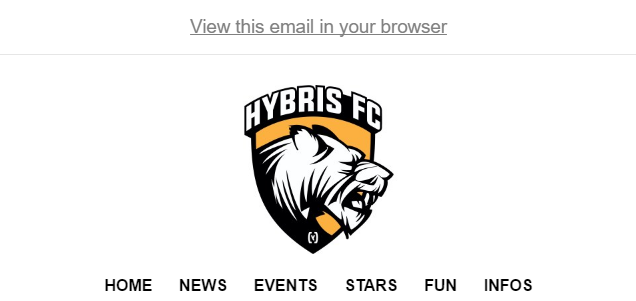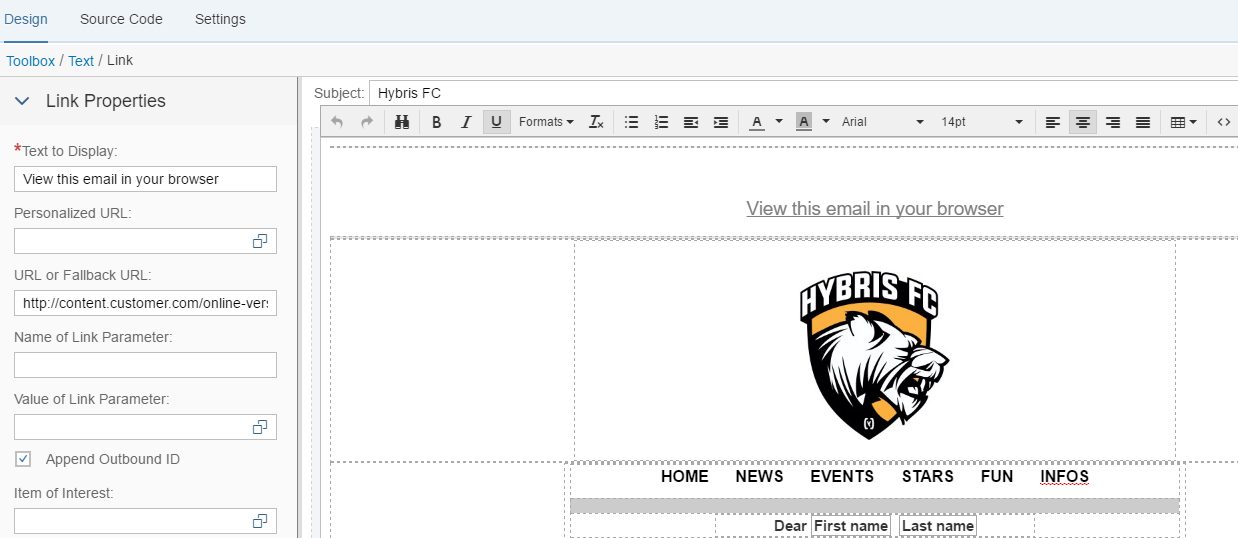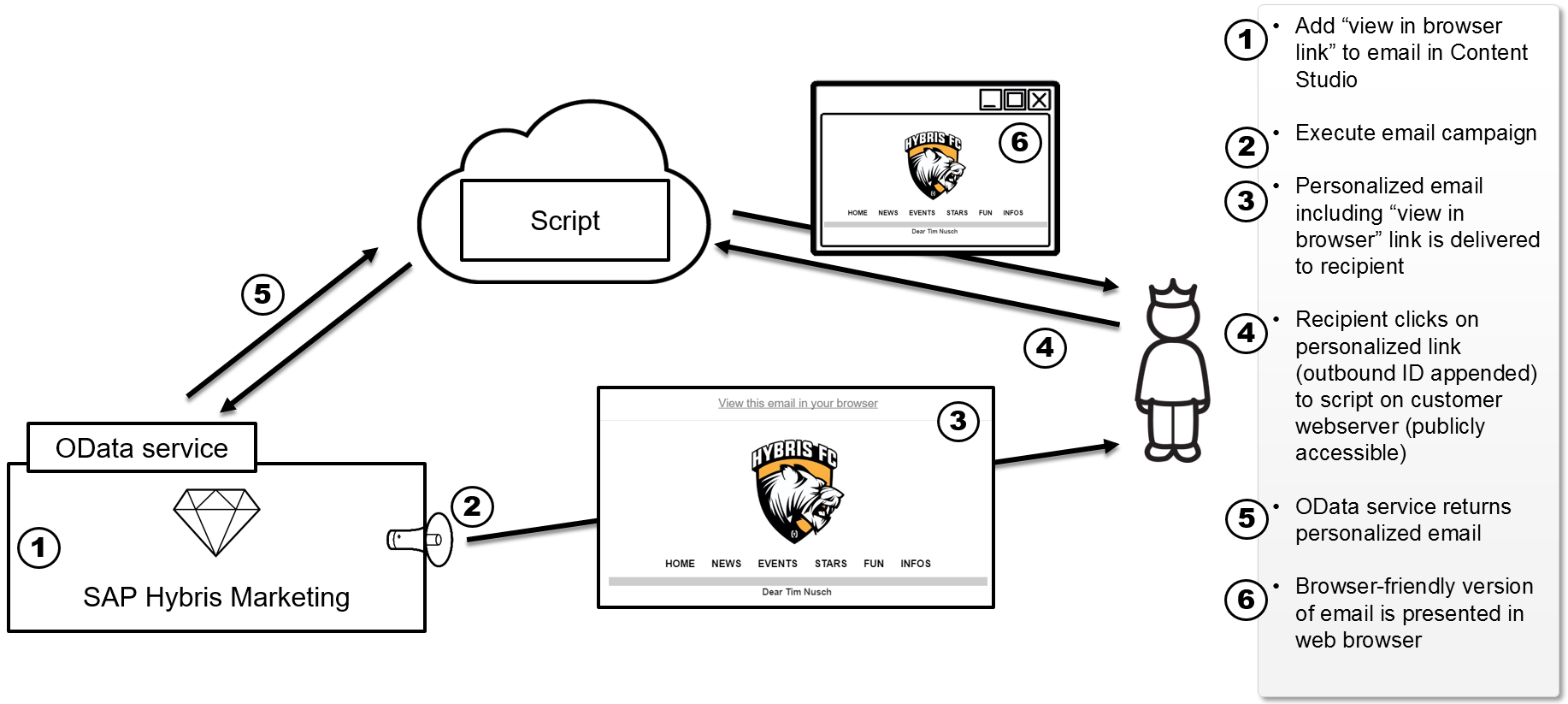
- SAP Community
- Products and Technology
- CRM and Customer Experience
- CRM and CX Blogs by SAP
- “View in Browser” functionality for SAP Marketing
CRM and CX Blogs by SAP
Stay up-to-date on the latest developments and product news about intelligent customer experience and CRM technologies through blog posts from SAP experts.
Turn on suggestions
Auto-suggest helps you quickly narrow down your search results by suggesting possible matches as you type.
Showing results for
former_member19
Active Participant
Options
- Subscribe to RSS Feed
- Mark as New
- Mark as Read
- Bookmark
- Subscribe
- Printer Friendly Page
- Report Inappropriate Content
12-21-2016
10:25 AM
With the 1708 release an API and reusable blocks which can be used to build a customer managed "View in Browser" functionality in the Cloud and in on-Premise has been implemented. Please follow this blog entry for more details.
SAP Marketing allows to design and send highly personalized and dynamic emails, as Jan describes in his blog entry. Unfortunately, some email clients and mobile devices don't support all HTML and/or CSS style elements such as CSS positioning or external stylesheets. Some email clients even block all images in emails by default.
These issues can get resolved by including a "view in browser" link to a browser-friendly version of the email. When recipients click the "view in browser" link, it opens a web page in their browser that displays the online version of the email. This way, any recipients whose email client or device doesn’t support all elements can still see the email the way it was intended to be seen.

Depending on the template, one of the following links can be added to the header or (less usual) in the footer of the email content:
The setup of the "view in browser" link within the Content Studio is shown below:

Once a recipient clicked on the "view in browser" link, SAP Marketing will automatically fetch the personalized email and open a web page in their browser that displays the online version of the email. The overall process in summarized below:

In more detail, the script (in this context a PHP script was used) on the web server is being called using the outbound ID from the personalized “view in browser” link. The “view in browser” OData service is then being called by the script using the same outbound ID.
The responsibility of the OData service is to return the personalized mail for a given outbound ID. The outbound ID can be used to uniquely identify both the personalization attributes (e.g. first name = Tim) for the recipient and the email content (e.g. Hybris FC mail) which was used by the email campaign. An exemplary logic which can be used to determine the email content (or more specifically: the email content ID) by the outbound ID is shown below in method GET_CONTENT_ID.
In the next step, the personalization attributes have to be determined using the outbound ID. The personalization attributes are persisted in the table CUAND_EXEC_HASH (UTF-8 encoded as JSON structure in the PLACEHOLDER_VALUES field). Combining both the personalization information and the email content, the personalized mail can be re-built. The exemplary method GET_HTML_CONTENT is shown below:
The overall process is shown in the picture below:

Once the personalized email has been re-built, it is returned from the OData service and handed over 1:1 by the service in order to display it in the web browser. Additionally, the service on the customer webserver can be adapted in a way that is displays content or redirects to a specific URL as a fallback option when the backend is not reachable.
This functionality has been built as a custom solution on top of SAP Marketing. In case of any questions, don’t hesitate to contact me.
SAP Marketing allows to design and send highly personalized and dynamic emails, as Jan describes in his blog entry. Unfortunately, some email clients and mobile devices don't support all HTML and/or CSS style elements such as CSS positioning or external stylesheets. Some email clients even block all images in emails by default.
These issues can get resolved by including a "view in browser" link to a browser-friendly version of the email. When recipients click the "view in browser" link, it opens a web page in their browser that displays the online version of the email. This way, any recipients whose email client or device doesn’t support all elements can still see the email the way it was intended to be seen.

Depending on the template, one of the following links can be added to the header or (less usual) in the footer of the email content:
- View this email in your browser
- Email not displaying correctly? View it in your browser.
The setup of the "view in browser" link within the Content Studio is shown below:

Once a recipient clicked on the "view in browser" link, SAP Marketing will automatically fetch the personalized email and open a web page in their browser that displays the online version of the email. The overall process in summarized below:

In more detail, the script (in this context a PHP script was used) on the web server is being called using the outbound ID from the personalized “view in browser” link. The “view in browser” OData service is then being called by the script using the same outbound ID.
The responsibility of the OData service is to return the personalized mail for a given outbound ID. The outbound ID can be used to uniquely identify both the personalization attributes (e.g. first name = Tim) for the recipient and the email content (e.g. Hybris FC mail) which was used by the email campaign. An exemplary logic which can be used to determine the email content (or more specifically: the email content ID) by the outbound ID is shown below in method GET_CONTENT_ID.
* +-------------------------------------------------------------------------------------------------+
* | Method GET_CONTENT_ID
* +-------------------------------------------------------------------------------------------------+
* | [--->] IV_EXEC_HASH TYPE /BOBF/CONF_KEY
* | [<-()] RV_CONTENT_ID TYPE CUAN_ME_ENGAGEMENT_ID
* +-------------------------------------------------------------------------------------------------+
METHOD GET_CONTENT_ID.
DATA:
lt_key TYPE /bobf/t_frw_key,
lt_action_parameter TYPE cuan_t_marketing_orc_act_par.
DATA(lo_srv_mktorc) = /bobf/cl_tra_serv_mgr_factory=>get_service_manager( iv_bo_key = if_cuan_marketing_orch_c=>sc_bo_key ).
APPEND VALUE #( key = iv_exec_hash ) TO lt_key.
lo_srv_mktorc->retrieve_by_association(
EXPORTING
iv_node_key = if_cuan_marketing_orch_c=>sc_node-execution_run
iv_association = if_cuan_marketing_orch_c=>sc_association-execution_run-to_parent
it_key = lt_key
IMPORTING
et_target_key = DATA(lt_action_key) ).
lo_srv_mktorc->retrieve_by_association(
EXPORTING
iv_node_key = if_cuan_marketing_orch_c=>sc_node-action
iv_association = if_cuan_marketing_orch_c=>sc_association-action-action_parameter
it_key = lt_action_key
iv_fill_data = abap_true
IMPORTING
et_data = lt_action_parameter ).
* read content ID from action parameter
READ TABLE lt_action_parameter ASSIGNING FIELD-SYMBOL(<ls_action_parameter>)
WITH KEY parameter_id = if_cuan_mkt_orch_constants=>sc_action_parameter_id-email_template_id.
IF sy-subrc IS INITIAL.
rv_content_id = <ls_action_parameter>-parameter_value.
ENDIF.
ENDMETHOD.In the next step, the personalization attributes have to be determined using the outbound ID. The personalization attributes are persisted in the table CUAND_EXEC_HASH (UTF-8 encoded as JSON structure in the PLACEHOLDER_VALUES field). Combining both the personalization information and the email content, the personalized mail can be re-built. The exemplary method GET_HTML_CONTENT is shown below:
* +-------------------------------------------------------------------------------------------------+
* | GET_HTML_CONTENT
* +-------------------------------------------------------------------------------------------------+
* | [--->] IV_EXEC_HASH TYPE CUAN_MKT_EXEC_HASH
* | [--->] IV_CONTENT_ID TYPE CUAN_ME_ENGAGEMENT_ID
* | [--->] IT_PLACEHOLDERS TYPE CUAN_T_ME_DYNAMIC_CONTENT
* | [<-()] RV_HTML TYPE STRING
* +-------------------------------------------------------------------------------------------------+
METHOD get_html_content.
DATA lo_email_handler TYPE REF TO cl_cuan_mkt_exec_email.
DATA lt_parameters TYPE cuan_t_mkt_exec_param.
DATA lr_dynamic_content TYPE REF TO cuan_t_me_dynamic_content.
DATA lt_outbounds TYPE cuan_t_mkt_exec_pers_content.
DATA ls_outbound TYPE cuan_s_mkt_exec_pers_content.
DATA lv_path TYPE string.
TRY.
CREATE OBJECT lo_email_handler TYPE cl_cuan_mkt_exec_email_amzn EXPORTING it_parameters = lt_parameters.
CATCH cx_root.
MESSAGE e012(cuan_mkt_exec_frw) INTO DATA(lv_message) WITH 'CL_CUAN_MKT_EXEC_EMAIL_AMZN'.
RETURN.
ENDTRY.
CREATE DATA lr_dynamic_content.
lr_dynamic_content->* = it_placeholders.
ls_outbound-dynamic_content = lr_dynamic_content.
ls_outbound-email_message_ref = lo_email_handler.
ls_outbound-personalization_hash = iv_exec_hash.
APPEND ls_outbound TO lt_outbounds.
lv_path = me->get_tracking_path( ).
cl_cuan_a_me_personalize=>convert_message( EXPORTING iv_campaign_content_id = iv_content_id
iv_host = lv_path
CHANGING ct_contacts = lt_outbounds ).
rv_html = lo_email_handler->if_cuan_mkt_exec_email~get_body_html( ).
ENDMETHOD.The overall process is shown in the picture below:

Once the personalized email has been re-built, it is returned from the OData service and handed over 1:1 by the service in order to display it in the web browser. Additionally, the service on the customer webserver can be adapted in a way that is displays content or redirects to a specific URL as a fallback option when the backend is not reachable.
This functionality has been built as a custom solution on top of SAP Marketing. In case of any questions, don’t hesitate to contact me.
- SAP Managed Tags:
- SAP Marketing
Labels:
23 Comments
You must be a registered user to add a comment. If you've already registered, sign in. Otherwise, register and sign in.
Labels in this area
-
Business Trends
270 -
Business Trends
9 -
chitchat
1 -
customerexperience
1 -
Event Information
256 -
Event Information
17 -
Expert Insights
30 -
Expert Insights
45 -
Life at SAP
133 -
Life at SAP
1 -
Product Updates
666 -
Product Updates
23 -
SAP HANA Service
1 -
SAPHANACloud
1 -
SAPHANAService
1 -
Technology Updates
453 -
Technology Updates
15
Related Content
- SAP Commerce Cloud Q1 ‘24 Release Highlights in CRM and CX Blogs by SAP
- Maximize Results and Drive Sustainability in Fashion Retail with SAP and GK AIR Dynamic Pricing in CRM and CX Questions
- SAP and SalesForce Custom Integration flows in CRM and CX Questions
- Search tuning in SAP Commerce Cloud in CRM and CX Blogs by SAP
- SAP Commerce Cloud Updates in 2023: A Not-So-Brief Summary for Technical Users in CRM and CX Blogs by SAP
Top kudoed authors
| User | Count |
|---|---|
| 3 | |
| 2 | |
| 2 | |
| 2 | |
| 2 | |
| 1 | |
| 1 | |
| 1 | |
| 1 | |
| 1 |